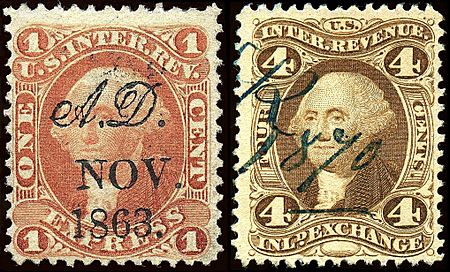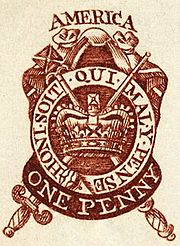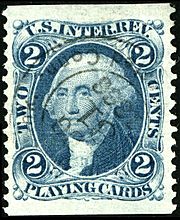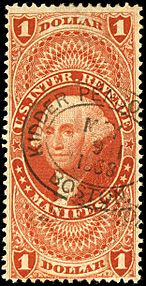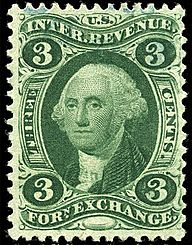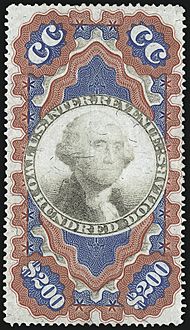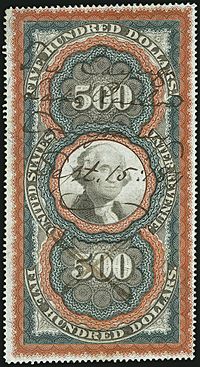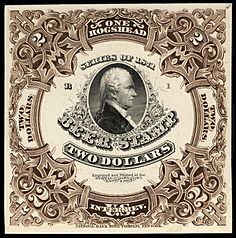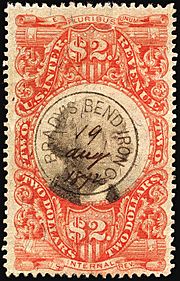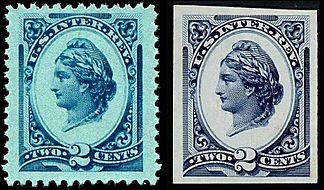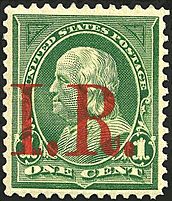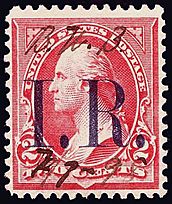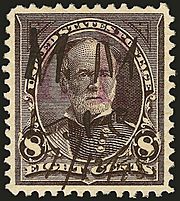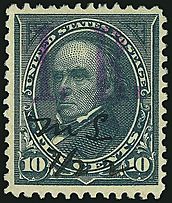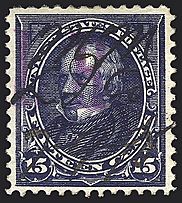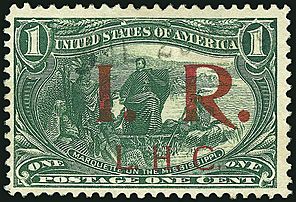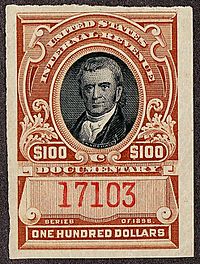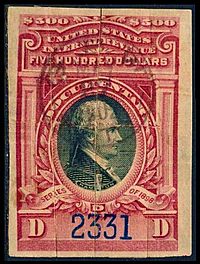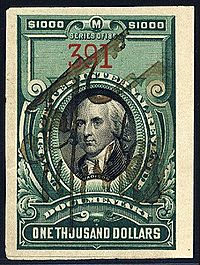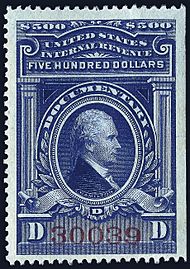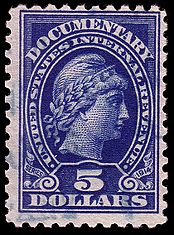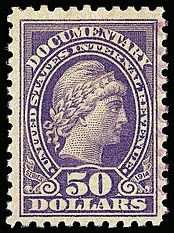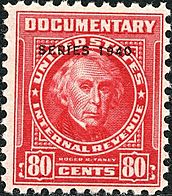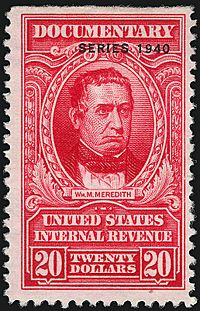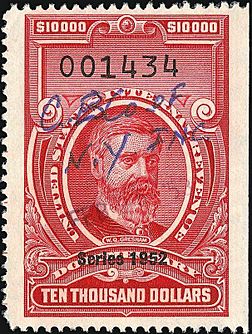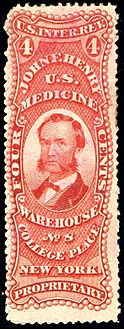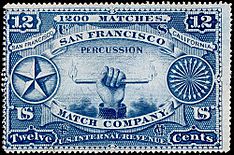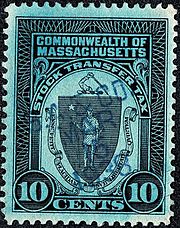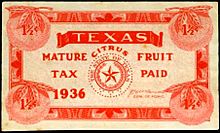Revenue stamps of the United States facts for kids
Imagine a special sticker that shows you've paid a tax! That's what a revenue stamp is. In the United States, these stamps were first used a long time ago, even before the country was fully independent, during colonial times. A famous example was the Stamp Act, which made colonists upset.
Much later, the U.S. government started printing its own revenue stamps during the American Civil War. They needed a lot of money to pay for the war. Even after the war ended, these stamps and the taxes they represented continued. Revenue stamps helped collect taxes on two main types of things: Proprietary items and Documentary items.
Proprietary stamps were for taxes on goods like alcohol and tobacco, and also for certain services. Documentary stamps were for taxes on legal papers, like mortgage agreements, stock certificates, and other official dealings. Sometimes, these stamps even looked similar, just with small changes. The first U.S. revenue stamps came out in 1862 and were used for over a hundred years. For the first 12 years, only George Washington was shown on them! Then, in 1875, a figure representing Liberty appeared. Collectors and historians love these stamps because they come in many different types and values. Revenue stamps were finally stopped on December 31, 1967.
How Revenue Stamps Were Used
The very first revenue stamps in America appeared before the American Revolution. This was because of the 1765 Stamp Act, which was a British law. The colonists really didn't like these taxes! These early stamps were British, and they meant that many printed papers in the colonies had to be made on special paper from London that already had a tax stamp pressed into it.
Civil War Era: The First U.S. Stamps
In August 1862, while the American Civil War was happening, the U.S. government (the Union side) began taxing many different goods, services, and legal papers. To show that a tax was paid, a 'revenue stamp' was bought and stuck onto the item. This stamp proved the tax was covered.
The government needed money for the war, so they asked companies to bid on printing the first U.S. revenue stamps. A company called Butler & Carpenter from Philadelphia won the contract. They were paid $19,080 to make all the printing plates and tools needed. Butler & Carpenter started making the stamps, which were first used on October 1, 1862.
It's a bit of a mystery why, but the government didn't pay Butler & Carpenter for their work until several years later. The company wrote many letters asking for their payment. One big problem was that the cost of materials had gone up a lot between when they agreed on the price and when they finally got paid.
The new stamps came in several colors and all showed a picture of George Washington. They ranged in value from one cent to $200. The picture of Washington was based on a painting by Gilbert Stuart. The first stamps were printed on stiff paper, and later ones on softer paper. Stamps made before 1868 usually had dull colors. They were sold in sheets with small holes (perforations) to tear them apart, or sometimes as solid sheets without holes. Washington remained the only person on these stamps until 1874.
These new revenue stamps paid taxes on things like playing cards, medicines, and luxury items. They also covered taxes on legal documents, stocks, and other business deals. People usually canceled these stamps by writing on them with a pen. Using a hand stamp to cancel them was rare, so those stamps are harder to find today.
When the Civil War ended, the taxes didn't stop. The government still had a huge debt of $2.7 billion to pay off. These taxes continued until 1883, when the government finally stopped them. Three different series of revenue stamps were made during this 21-year period.
One interesting use of these stamps was for photographs. During the Civil War, many people wanted photos of family members or soldiers. The government saw this as a chance to raise money. So, on August 1, 1864, they started a 'photograph tax'. Since there weren't special "photography tax" stamps, photographers often used proprietary or playing card revenue stamps, usually stuck to the back of the photo.
Photographers already had high costs and limited materials because of the war. So, large photography companies complained to Congress, saying they were paying too much tax. After two years of trying, the tax was finally removed on August 1, 1866. Other common products like cotton, tobacco, and alcohol also had a proprietary tax, which brought in a lot of money for the government.
First Issue Designs
The first series of revenue stamps had two main design types, and each stamp showed what tax it was for. Stamps from 1-cent to 20-cents were simple, just showing George Washington. Stamps from 25-cents to 1-dollar were larger and had more detailed designs. They also named the tax in a banner at the bottom.
For example, $1.30 stamps were only for foreign exchange taxes. $1.50 stamps were only for inland exchange. Stamps for $1.60 and $1.90 were also for foreign exchange but oddly didn't say so on the stamp. Higher value stamps, from $2 to $10, had the tax type around Washington's picture. Stamps from $15 to $50 had the tax type on the right side of the circle around his picture. The 1-cent stamp had a unique design not used for any other value.
- Some tax types included:
- Agreement
- Bank check
- Bill of lading
- Bond
- Certificate
- Charter party
- Contract
- Conveyance
- Entry of goods
- Foreign exchange
- Inland exchange
- Lease
- Life insurance
- Manifest
- Mortgage
- Passage ticket
- Playing cards
- Power of attorney
- Probate of will
- Proprietary
- Surety bond
Not all tax types were on every stamp value. For example, "Playing cards" stamps only came in 2, 3, 4, 5, and 6 cents. The 25-cent stamp was the only one that said "Bond." To see all the different combinations, you would need a special stamp catalog.
Second Issue: Preventing Reuse
The second set of revenue stamps, called Documentary stamps, came out in 1871. The government had a problem: people were cleaning the cancellation ink off stamps and using them again! Officials on Wall Street even wrote a letter in 1867 saying the government was losing "thousands of dollars daily" because stamps were being reused. The regular stamps at the time didn't hold the cancellation ink very well.
The letter suggested printing stamps in a pale yellow color. The printers, Butler & Carpenter, didn't do that. Instead, after trying different things, they made stamps with lighter colors and on paper that soaked up ink better. The government often sent suspicious stamps to the printers to check if they had been tampered with.
New paper was finally used in early 1869. By 1871, the second series of stamps was released. These were printed on special "chameleon" paper that had tiny silk fibers you could see. Butler & Carpenter still made them. All the stamps in this second series, except for the $200 one, were printed in two colors: Washington's picture in black, and the fancy border in blue.
- "Persian Rug" Stamps
The highest values in the second series were the $200 and $500 stamps. Collectors often call them the Small and Large Persian rug revenue stamps. Many people think they are some of the most colorful and beautifully designed stamps ever made.
Very few of these high-value stamps were printed. Only 446 of the $200 "Small Persian Rug" stamps were made, and about 125 are known to still exist. These stamps were printed one per sheet, with blank edges. The only full sheet of the "Small Persian Rug" that still exists was used to pay taxes on a will in 1872.
The $500 "Large Persian Rug" stamp is bigger, about 2.125 by 4 inches. Only 204 of these were ever issued. Because they were so large and had many perforations (holes for tearing), and because they were often folded on documents, most of them have some small damage. A $5,000 stamp was also planned, and a test print was made, but it was never actually used.
Alcohol Revenue Stamps
Taxes were often placed on alcohol and tobacco products. Many different stamps were printed for this reason. Usually, the stamp was stuck onto a container in a way that sealed it. When you opened the container, the stamp would get damaged, so it couldn't be used again. For example, beer tax stamps were given to brewers in sheets. A stamp would be cut out and used to seal a barrel of beer. To get to the beer, you had to break the stamp, which stopped anyone from reusing it.
Third Issue: New Colors
Because all the second issue revenue stamps were printed in the same blue and black colors, it was hard for tax workers to tell them apart quickly. So, a third set of stamps was released between 1871 and 1872. These stamps had similar designs to the second issue, but each value had its own distinct color.
The third issue used many of the same printing plates and the same special "chameleon" paper with silk fibers. They also had the same perforations (holes) for tearing. Unlike many stamps in the second issue, the third issue stamps did not say what type of tax they were for. Sometimes, these stamps had printing errors, like double images or upside-down centers.
By 1875, a new company, the National Bank Note Company, got the contract to print revenue stamps. They made a second series of proprietary stamps. These new stamps are called the "second proprietary issue" and came in values from 1-cent to 6-cents. The use of revenue stamps for proprietary taxes ended on July 1, 1883.
Liberty Stamp of 1875
In 1875, the tax department released a 2-cent revenue stamp that showed a figure representing Liberty. This was a big deal because it was the first U.S. revenue stamp that did not have George Washington's picture on it! These Liberty stamps were printed on bluish paper with silk fibers. They came with two types of perforations: regular holes and a "rouletted" type, which are like small cuts instead of holes. Stamps made in 1878 were printed on paper with a double-lined watermark. A huge number of these stamps were printed: over 228 million! We don't know exactly how many of each perforation type were made.
Overprints of 1898: Helping Fund a War
On June 13, 1898, Congress passed a law called the War Revenue Act of 1898. This law was meant to raise money for the Spanish–American War. The law was supposed to start on July 1, 1898, which left only 17 days to make the needed revenue stamps!
The Bureau of Engraving and Printing had already started working on the designs, but they couldn't get the new stamps ready in time. To solve this, they took regular postage stamps that were already in use (from 1895–1898) and printed the letters I.R. (which stood for Internal Revenue) over them. This made them usable as revenue stamps. On some stamps, like the 8, 10, and 15-cent ones, the I.R. initials are hard to see.
Because there weren't enough revenue stamps, two shipping companies on the Erie Canal used existing 1-cent Trans-Mississippi postage stamps. A government tax collector approved this. He hired a printing company to print I.R. on them. One company, Chapman Steamboat Line, used 250 of these stamps. Another company, P.I. Daprix & Son, also had 250 stamps printed with "I.R./P.I.D. & Son." In both cases, five sheets of 50 stamps each were overprinted.
New Issues of 1898
To keep funding the Spanish–American War, Congress allowed taxes on many goods and services. This included alcohol, tobacco, tea, entertainment, and business deals like Stock certificates, shipping papers, and marine insurance. To pay these taxes, people bought revenue stamps and stuck them on the taxable item or document.
This issue had 17 different stamps, from ½-cent to $50. They were printed on paper with a double-lined watermark. Two types of perforations were used: rouletted (small cuts) and "hyphen" shaped cuts. Many of these stamps also had printing errors, like doubled images.

Stamps depict the image of the USS Maine
- Stamps from ½-cent to 80-cents showed a battleship.
- Stamps from $1 to $50 showed a standing figure representing Commerce (business). This design was similar to ones used in 1875 and 1895. A second printing in 1900 had a large number "1" printed over it, in two different styles.
Documentary Series of 1898 (Issued 1899)
The three Documentary stamps from the 1898 series (which actually came out in 1899) featured portraits of important historical figures: John Marshall, Alexander Hamilton, and James Madison. Each stamp said "Series of 1898." These same designs were used again in 1914, 1917, and even 1940, but with small changes, like removing the "Series of 1898" text.
To make these high-value stamps more secure, each one had its own unique serial number. The Bureau of Engraving and Printing made these stamps on white paper with a watermark that said "U.S.I.R." (United States Internal Revenue) in capital letters. They were separated by rouletted perforations. The stamps from 1917 and 1940 were also on double-lined watermarked paper with standard perforations.
Issues of 1914
The revenue stamps from 1914 had two main design types. Lower values (½-cent to 80-cents) had the value circled. Higher values (1-dollar to 50-dollars) showed an image of freedom in profile.
The lower value stamps were printed on paper with both single and double-line watermarks. The higher value stamps were only printed on double-lined watermarked paper.
Issues of the 1940s and 1950s
From 1940 to 1958, the tax department released hundreds of Documentary revenue stamps. They had three basic designs and values from 1-cent to $10,000. Each stamp value featured a different portrait of a famous statesman. Almost all of these stamps were printed in a "carmine" red color. The higher values, from $30 to $10,000, had a unique serial number for extra security. Some stamps from 1917 were also reprinted during this time.
Private Company Stamps
After the tax laws passed in 1862, private companies could make their own tax stamps. The government had to approve them, and companies got a discount on taxes if they used their own stamps. The benefit for companies was that their name could be on the stamp!
Companies paid for the design and printing plates. At first, the cost varied a lot, from $60 to $750. After June 1, 1863, a standard cost of $350 was set for most designs.
Most of these private stamps were printed by Butler & Carpenter, the same company that printed stamps for the government. Many of these stamps were designed to seal a container or package, so they were often long and would be destroyed when opened.
Four types of paper were used for these private stamps:
- White, plain paper (until September 1871).
- "Experimental silk" paper, with a few silk threads.
- "Full silk paper," with many silk threads (1871-1878).
- "Pink paper" (a short time in 1877-1878).
- Watermarked paper with "USIR" (late 1877 until 1883).
The use of private stamps started again from July 1, 1898, to July 1, 1902, to help fund the Spanish–American War. Taxes were placed on medicines, wines, perfumes, and cosmetics. However, only a small number of companies used private stamps during this period.
State Revenue Stamps
Besides the federal revenue stamps used across the whole country, individual states also issued their own revenue stamps. These were for various purposes, like sales tax or even permits for duck hunting.
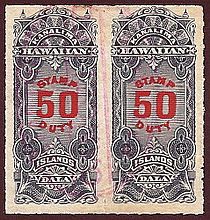
Hawaii revenue stamp, $50
|
Varieties of Revenue Stamps


